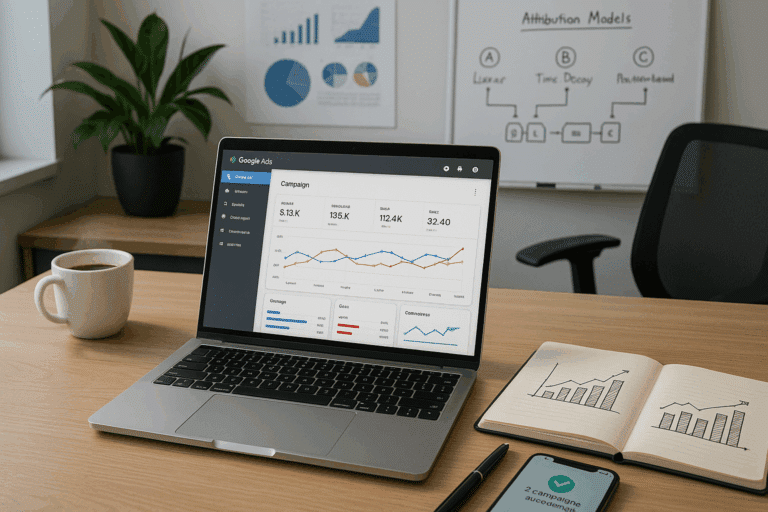It’s a common conundrum for marketers, but fear not, Google’s GA4 Attribution is here to illuminate your path. This powerful tool transforms raw data into meaningful insights, empowering your marketing strategy with crystal clear clarity. 🔮
However, like any advanced tool, the power of GA4 Attribution lies in understanding its functionality and knowing how to leverage it effectively. That’s where this comprehensive guide steps in to bring you up to speed. 🚀
Through this article, we’ll journey through the mechanics of GA4 Attribution, breaking down complex concepts into digestible insights. From the foundational understanding of attribution models to the process of setting up GA4 Attribution, we’ll traverse the landscape of this tool to leave you with a solid grasp and ready for action.
🎯 But why is understanding GA4 Attribution so crucial, you might ask?
Imagine embarking on a long road trip without a map. You could end up driving in circles, wasting time, and resources, while your destination remains elusive. Similarly, without a clear understanding of your customer journey, your marketing efforts can feel aimless, and measuring your campaign’s success can become a guessing game. GA4 Attribution serves as your roadmap, illuminating your customer journey, showing you where your efforts are bearing fruit, and where there’s room for improvement.
💡 So, What’s In Store?
As we dive deeper into the world of GA4 Attribution, we’ll begin by decoding the fundamentals of attribution modeling, setting a solid foundation for your understanding. With the basics under your belt, you’ll be ready to tackle more complex aspects, such as configuring and analyzing GA4 Attribution reports.
Once we’ve explored the technical side, we’ll shift gears to examine practical applications. We’ll look at real-world case studies, highlighting the successes and lessons learned from businesses who’ve harnessed the power of GA4 Attribution. 🌐
To wrap it up, we’ll provide you with actionable tips and strategies to integrate GA4 Attribution into your digital marketing toolkit seamlessly. It’s not just about knowing the tool; it’s about leveraging it to its fullest potential, turning data into actionable insights that can drive your marketing success.
This comprehensive guide promises to take you from feeling overwhelmed by GA4 Attribution to feeling empowered and ready to conquer your digital marketing challenges.
🔑 Key Takeaways Await
Be ready for a deep dive into GA4 Attribution’s potential, unravelling its complexities to lay bare the opportunities it presents for your marketing strategy. With this guide, you’ll gain not just technical knowledge, but also practical insights, helping you to convert data into success stories.
Remember, the power of GA4 Attribution is not in its complexity, but in its ability to simplify your marketing data, making it understandable, actionable, and transformative. So, buckle up and prepare to uncover the power of GA4 Attribution, simplified for your success.
Unraveling the GA4 Attribution Powerhouse: A Simplified Guide to Propel Your Success
Every business thrives on insights, and in today’s world, most of these insights are driven by data. Yet, data in its raw form can often be overwhelming and challenging to interpret. Enter Google Analytics 4 (GA4) – a powerful tool designed to take your data analysis to new heights. But how can we unlock the true potential of GA4? By understanding its attribution models and their practical application, we can leverage this tool to maximize our marketing strategies. Let’s embark on this journey of discovery together.
Before we dive deeper, it’s crucial to understand the term “attribution” in digital marketing. Attribution refers to the process of identifying which marketing channels or touchpoints contribute to a conversion or sales. In other words, it gives credit where credit is due. In the context of GA4, attribution models are the rules or sets of rules that determine how conversion credit is assigned to different marketing touchpoints. Now, let’s take a closer look at the different attribution models available in GA4.
Google Analytics 4 boasts several attribution models, each with its own unique method of distributing credit among various touchpoints. To help you understand and compare them better, here is a simplified comparative table:
| Attribution Model | Description |
|---|---|
| Last Engagement | Assigns 100% credit to the last engagement. |
| First Engagement | Assigns 100% credit to the first engagement. |
| Linear | Distributes the credit equally across all engagements. |
| Time Decay | Assigns more credit to engagements that happened closer in time to the conversion. |
| Position Based | Assigns 40% credit each to the first and last engagement, and 20% spread out amongst the rest. |
For a more visual understanding of these attribution models, watch this video titled “GA4 Conversion Paths and Attribution Models Explained” on the MeasureSchool YouTube channel. It provides an excellent overview of these models with clear, visual examples.
Maximizing GA4 Attribution for Your Success: An Actionable Guide
Now that we have a basic understanding of GA4 attribution models, let’s explore how we can utilize them to elevate our marketing success. Keep in mind that the model you choose should align with your business goals and marketing strategy. For instance, if you aim to drive awareness, the “First Engagement” model may suit you best. However, if your goal is to nudge potential customers towards a purchase, the “Last Engagement” or “Time Decay” model may be more beneficial.
One of the most powerful features of GA4 is its ability to compare different attribution models side by side. This feature gives you a comprehensive view of how different models assign credit to various touchpoints, providing valuable insights into which model aligns best with your marketing strategy. To utilize this feature, navigate to “Conversions > Attribution > Model Comparison” in your GA4 dashboard.
Another feature that sets GA4 apart is its predictive capabilities. Using machine learning, GA4 can predict future user actions, such as the likelihood of purchase or churn. By integrating this predictive analysis with attribution modeling, you can create highly targeted marketing strategies. For instance, if GA4 predicts a high likelihood of churn, you can utilize the “Last Engagement” model to identify the most recent touchpoints and focus your retention efforts there.
The Future of GA4 Attribution: What’s Next?
Google Analytics 4 is constantly evolving, with new features and updates being rolled out regularly. One of the most anticipated updates is the introduction of data-driven attribution (DDA). DDA uses machine learning to determine the importance of different touchpoints, assigning credit based on their actual impact on conversions. Once DDA is available in GA4, it will undoubtedly revolutionize the way we use attribution modeling.
In the meantime, it’s crucial to stay updated with the latest GA4 features and updates. Consider subscribing to reliable sources like the Google Analytics YouTube channel and the Google Marketing Platform Blog. These platforms provide timely updates and valuable resources to help you stay ahead of the curve.
So, now it’s your turn to uncover the power of GA4 attribution. Explore different models, experiment with different strategies, and continue learning. Remember, the road to success in digital marketing is paved with continuous learning and adaptation. Now, go ahead and leverage the power of GA4 attribution to propel your success!

Conclusion
In conclusion, we have traveled through an extensive journey of understanding the ins and outs of the tech world. We’ve delved into various concepts within the IT and engineering sectors, and I hope that this technical writing has provided you with a comprehensive and understandable explanation of these intricate ideas.
We began by exploring the fundamentals of Software Engineering, a field that I hold dear due to my own background. We shed light on its importance in today’s digital world and the various roles that a software engineer can play, from coding to troubleshooting to system designing. In our fast-paced technological era, the role of a software engineer is more crucial than ever. 💻🔧
Following this, we took a closer look at the vast world of Information Technology, or as it’s more commonly known, IT. We discussed how it’s not just about computers, but also involves managing information, systems, and processes to help organizations achieve their goals. Furthermore, we highlighted how IT continues to transform businesses and our lives as a whole. 🖥️🌐
Additionally, we explored the intricate relationship between IT and Software Engineering. While they may seem similar, we highlighted the distinct roles they play and how they complement each other in creating seamless and efficient systems.
Now, let’s not forget the role of a technical writer. As a person who’s spent over a decade in this field, I can confidently say that the ability to translate complex concepts into understandable terms is an art in itself. 🖋️📚
The topics we have covered are not just important, they are the driving forces behind the technological advancement we witness today. I hope that this article has inspired you to delve deeper into these areas, whether for personal interest or professional growth.
As we come to a close, I would love to hear from you. Did you find this article informative? Did it help in demystifying some of the complex concepts in the tech world? What other topics within IT and engineering would you like to learn more about? Feel free to leave a comment below or share this article with others who might find it helpful. And remember, in our rapidly evolving world, continuous learning is key. 🌟🌱
And finally, I would like to leave you with this thought: “The technology you use impresses no one. The experience you create with it is everything.” – Sean Gerety
Until next time, keep learning, keep exploring, and keep pushing the boundaries of what’s possible with technology. 🚀
References:
1. IBM
2. Microsoft
3. Google Developers



